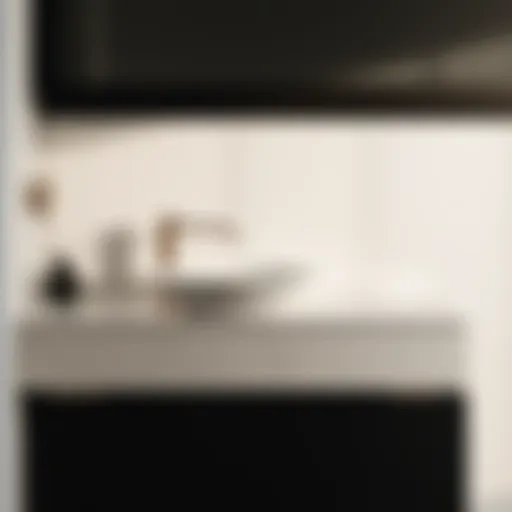Choosing 108 x 84 Vertical Blinds for Your Home
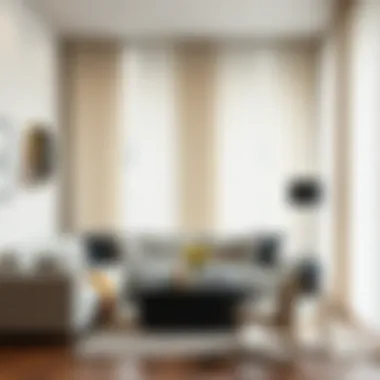

Intro
Vertical blinds, with dimensions of 108 x 84 inches, often serve as both practical solutions for window treatment and striking design elements in a home. Their functionality allows for effective light control while providing unfettered views when opened fully. Heat insulation offered by these sturdy slats makes them a smart choice in regions facing extreme temperatures, while their versatility in color and texture can elevate the overall aesthetic of any room. This narrative will unfold the multifaceted world of vertical blinds, delving into material choices, installation processes, and maintenance considerations. With an eye toward current design trends, we aim to allow homeowners and decorators alike to make thoughtfully informed decisions.
Design Trends
Current Trends in Furniture Styles
The integration of vertical blinds into interior environments cannot be looked at in isolation; rather, it reflects larger trends in furniture and home décor. Minimalistic and Scandinavian styles remain at the forefront, emphasizing clean lines and functional furniture. Vertical blinds fit seamlessly into these themes with their simple functionality, merging ease with elegance.
As open floor plans gain popularity, spaces flow from one area to another without distinct boundaries. Here, vertical blinds become crucial in negating the harshness of direct sunlight while still maintaining openness. You may notice that neutral colors are bouncing back in popularity—such as soft grays and beiges—which pairs well with sheer or semi-sheer vertical blinds. This combination softens harsh angles and sharp outlines that are often a hallmark of contemporary design.
How to Incorporate Trends into Your Space
To best incorporate vertical blinds into your interior design, consider the following:
- Color Coordination: Match the blinds with nearby furniture or accent walls to create harmony.
- Layered Textures: Layering vertical blinds with curtains adds depth and visual interest.
- Functional Arrangements: Positioning furniture to maximize natural light yet protect from glare is key; think of furniture placements that make sense with the direction of sun.
Focusing on balance and lightness in design can help you choose the right fabric and color for your vertical blinds, ensuring they complement rather than clash with your overall theme.
Buying Guides
Choosing the Right Vertical Blinds for Different Rooms
A primary consideration when selecting vertical blinds revolves around the intended room usage. Options vary widely, and a few practical suggestions can guide you:
- Living Rooms: Opt for fabric or faux wood to introduce warmth and coziness.
- Kitchens: Consider easier-to-clean materials like vinyl, especially since these spaces can accumulate grime.
- Bedrooms: Blackout vertical blinds can enhance privacy and improve sleep quality.
- Home Offices: Louvers with adjustable slats grant flexibility for light management during work hours.
Tips for Assessing Quality and Value
When investing in vertical blinds, quality is paramount. Check for the following:
- Durability: Materials like high-grade PVC or aluminum often offer better longevity and performance.
- Fitting Accuracy: Ensure that measurements are precise; ill-fitting blinds can lead to light leakage and aesthetics issues.
- Mechanism Ease: Look for smooth operation mechanisms—whether it be corded, cordless, or motorized.
Researching options online through Wikipedia or forums on Reddit can also offer insights into user experiences, enhancing your understanding and guiding your choices.
Understanding Vertical Blinds
Vertical blinds play a pivotal role in modern interiors, often being a preferred choice for large windows or sliding glass doors. Their unique design not only offers functionality but also provides aesthetic appeal, making them a go-to option among homeowners and designers alike. The dimensions of vertical blinds, particularly the 108 x 84 specification, bring about a series of considerations and benefits, further emphasizing their importance in home decor.
Definition and Purpose
At its core, vertical blinds are a type of window covering composed of vertical slats that tilt, slide, or both, to control light and privacy. The slats can be made from various materials, each carrying its unique set of characteristics. These blinds are especially useful for spaces requiring flexibility in light control. Homeowners have the option to completely open or partially close these blinds, allowing for a seamless transition from bright daylight to cozy shadows.
When one speaks of vertical blinds, it’s not just about sheer curtain alternatives. It’s about curating an atmosphere—one that reflects both style and functionality. Their purpose spans beyond basic coverage; they provide insulation, contribute to energy efficiency, and can even assist in noise dampening. Moreover, many homeowners opt for vertical blinds for their practicality in spaces that receive direct sunlight, allowing for effective glare reduction.
The Role of Size in Functionality
The size of any window treatment plays a crucial role in both its appearance and function. The 108 x 84 measurements are particularly favorable for expansive windows or glass doors. The height allows for ample coverage while maintaining a sleek look. Larger blind sizes like this can create an illusion of taller ceilings and larger spaces, an attractive quality in interior design.
Moreover, the width provides a substantial barrier against sun rays, enhancing the privacy aspect of the user's environment. When considering the vertical blinds’ mechanism, the size contributes to ease of operation. Larger panels tend to glide more fluidly, improving the user experience.
In practical terms, fitting 108 x 84 blinds often means fewer seams compared to smaller options, leading to a cleaner visual line and better durability. Effectively, the right dimensions make a considerable difference—not just in form but in function as well. Ultimately, it’s about finding the perfect balance between aesthetic appeal and practical utility in your living spaces.
The x Measurement
The dimensions 108 x 84 inches hold significant weight in the world of vertical blinds. This specific measurement is not just arbitrary; it serves critical purposes in functionality, aesthetic appeal, and even energy efficiency. When selecting vertical blinds, understanding these dimensions can steer homeowners and designers toward making well-informed choices that enhance their spaces while fulfilling practical needs.
Significance of Dimensions
To grasp the value of the 108 x 84 specifications, one must first contemplate the relationship between sizing and the corresponding effects on light, privacy, and air circulation. Vertical blinds of this size are particularly beneficial for large windows and sliding glass doors, which are common in many modern homes. Having 84 inches in height allows them to cover windows or openings that reach nearly to the floor, while the width of 108 inches provides ample coverage to either side.
When it comes to light control, larger dimensions mean more extensive coverage. Homeowners can twist the slats to filter sunlight without entirely blocking it out, allowing for a comfortable balance between natural light and shade. Proper sizing also ensures that privacy is maintained, as occupants are shielded from unwanted views from the outside. With this kind of dimension, a room feels more alive and spacious, providing a suitable canvas for interior decor.
"The right dimensions in vertical blinds not only enhance appearance but also amplify energy efficiency and comfort within a living space."
Ideal Applications for x Blinds
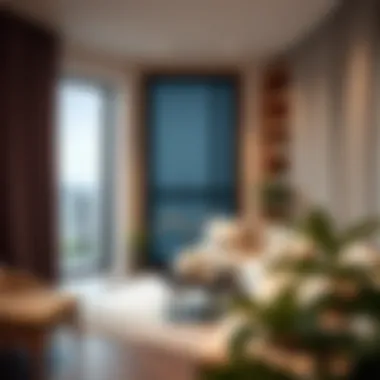

When considering where 108 x 84 vertical blinds are most ideally suited, a few applications come immediately to mind:
- Living Rooms and Family Rooms: These areas often feature large windows, making them prime candidates for vertical blinds of this size. They allow for ample daylight while still providing privacy when needed.
- Patio Doors: Translating indoor comfort to outdoor lounging areas is simpler when using sizable vertical blinds. Their length is perfect for sliding doors, and their configuration facilitates easy operation, whether they are opened fully or partially.
- Commercial Spaces: Offices with large glass facades can benefit from these blinds as well. The versatility of adjusting light makes it easier for workers to concentrate without harsh sun rays interrupting their work flow.
- Dining Areas: These spaces can transition from bright daylight to cozy evening settings, making the control of light a priority, and 108 x 84 vertical blinds can accommodate this beautifully.
In summary, the 108 x 84 measurement of vertical blinds opens up a slew of possibilities for functionality and design, marrying practicality with style. Ensuring that your window treatments fit appropriately can enhance the overall ambiance of any room, allowing aesthetics and utility to coexist harmoniously.
Material Options for Vertical Blinds
When it comes to selecting vertical blinds, the material you choose plays a pivotal role in both functionality and aesthetics. The right material can enhance your home’s charm while serving practical purposes like light control, insulation, and privacy. In this section, we will explore various material options such as fabric, vinyl, and aluminum, evaluating their unique attributes and potential performance in residential settings.
Fabric Blinds
Fabric blinds are celebrated for their versatility and sophistication. Often this option presents itself with a variety of textures and colors that can suit nearly any interior design style. They not only add warmth but also provide a soft touch to windows. Some people prefer fabric blinds because they can diffuse sunlight, creating a gentle glow in the room rather than harsh brightness.
However, it's essential to keep in mind that fabric blinds may require more maintenance than other options. They collect dust and might stain more easily—especially in high-traffic areas. For those living with pets or young children, this might be a significant consideration. Washing them may require a delicate approach, so ensure you understand the manufacturer's instructions on cleaning to maintain their appearance.
Key Benefits of Fabric Blinds:
- Aesthetic Variability: Available in various colors and patterns.
- Light Filtering: Softens the light without completely blocking it.
- Insulation Properties: They can provide warmth in winter and coolness in summer.
Vinyl Blinds
Vinyl blinds are one of the most practical choices for homeowners who prioritize durability and ease of care. This type of blind stands up remarkably well against moisture, making it a preferred choice for areas like kitchens and bathrooms. They are also resistant to fading, which is a welcome trait in sunny locations.
The downside to vinyl is the more minimal design options compared to fabric. While some styles do imitate fabric looks, they often lack the richness that a fabric blind might bring to a living room or bedroom. However, their practicality often outweighs aesthetic limitations. The straightforward cleaning process is another plus — a quick wipe down usually does the trick.
Key Benefits of Vinyl Blinds:
- Durability: Resistant to moisture and fading.
- Easy Maintenance: Simple to clean and maintain.
- Cost-Effectiveness: Often more affordable than other materials.
Aluminum Blinds
Aluminum blinds bring a modern touch to your space. Known for their sleek finish and clean lines, aluminum blinds can fit seamlessly into contemporary design schemes. They are robust and can handle a bit of rough treatment—perfect for homes where durability is a priority.
These blinds can also reflect sunlight, which can help keep rooms cooler in the summertime. However, this can also mean that controlling the exact amount of light admitted can be a little tricky as they don’t provide as much softness in light diffusion compared to fabric alternatives.
One noteworthy downside is that aluminum can be prone to denting and scratches if not handled with care. Thus, while they are visually appealing and functional, it's good to consider where they’ll be installed and how they’ll be used.
Key Benefits of Aluminum Blinds:
- Modern Aesthetic: Compliments contemporary decor.
- Light Reflectivity: Aids in keeping spaces cool.
- Strength: Can withstand a fair amount of wear and tear.
Choosing the right material for vertical blinds is crucial—consider not just the look, but also how each option aligns with your lifestyle and cleaning habits.
Installation Procedures
Installing vertical blinds, especially those with the measurement of 108 x 84 inches, is not just a matter of hanging some fabric and calling it a day. This section of the article scrutinizes the steps, tools, and potential pitfalls in the installation process. The right installation can significantly impact functionality and aesthetics. It’s crucial for anyone looking to make their living spaces inviting while ensuring that the blinds operate smoothly.
Tools Required for Installation
Before diving into the installation, it’s wise to gather all your tools to avoid running back and forth. Here’s a rundown of what you’ll need:
- Measuring Tape: Essential for confirming dimensions and ensuring everything fits as it should.
- Screwdriver: Typically a Phillips head, necessary for securing brackets.
- Drill: If you’re mounting the blinds on a solid surface, having a drill makes the task much simpler.
- Level: To ensure your blinds hang evenly. Nobody wants lopsided window treatments!
- Ladder: If you’re dealing with high windows, a sturdy ladder will be vital.
- Pencil: For marking your drill points. Remember, measure twice, cut once!
It’s always better to have extras on hand. For instance, additional screws or anchors may come in handy during the installation process.
Step-by-Step Installation Guide
With tools assembled, it’s time to get your hands dirty. Here’s a step-by-step guide to follow:
- Measure Your Window Frame: Begin by assessing the area where you will install the blinds. Accurate measurements can save a lot of headaches later.
- Mark the Bracket Locations: Use your pencil to indicate where the brackets will go. Ensure the marks are level and equal distances apart.
- Drill Holes: For the brackets, drill holes based on your marks. If you're mounting into drywall, consider using drywall anchors.
- Attach the Brackets: Secure the brackets using screws. This is where the screwdriver (or drill) comes into play.
- Hang the Blinds: Once the brackets are in place, carefully hang the blinds onto the brackets. This part can often require a second set of hands to stabilize things.
- Test the Mechanism: Pull the cord or wand to see if the blinds operate smoothly. If they do, congratulations!
- Make Adjustments: If the blinds appear uneven or catch on something, adjust the brackets or ensure the blinds are hanging correctly.
Installation Tip: Always follow the manufacturer's instructions for specific guidance related to your particular brand of blinds.
Common Installation Challenges
Even with careful preparation, challenges can crop up during installation. Here are some common obstacles you might face:
- Misalignment: One of the most frequent issues. If not measured properly, the blinds can hang unevenly, leading to a less polished look.
- Obstructed Views: Sometimes, window handles or obstacles like radiators can interfere with how the blind operates. Identify these before you start.
- Wall Material Variation: Different wall materials may require different tools or screws. You might find, for instance, that plaster walls need specific anchors that aren’t required for wood or concrete.
- Heavy Blinds: Blinds of this size can be quite heavy. If you’re working alone, it can be tricky to lift and attach them to the brackets without help.
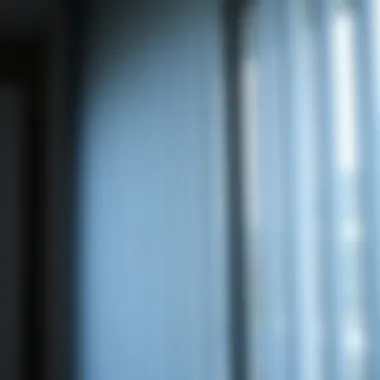

Functional Benefits of Vertical Blinds
Vertical blinds are more than just a decorative addition to a room. They serve several functional purposes that can significantly impact comfort and style within a living space. Understanding these benefits is key for homeowners and designers alike when selecting 108 x 84 vertical blinds. Here are some fundamental aspects to consider:
Light Control and Privacy
One of the primary advantages of vertical blinds is their ability to regulate light and provide privacy. With a quick twist of the wand, you can adjust the slats to let just the right amount of sunlight filter into your room. This is particularly useful for large windows or patio doors where controlling exposure can be tricky.
For instance, during mid-day, sunlight can be intense. A homeowner could slightly tilt the blinds to mitigate glare on TV screens or computer monitors without sacrificing natural light entirely. Conversely, in the evening hours, closing the slats creates an intimate setting while keeping nosy neighbors at bay.
- Versatile Operation: Depending on your needs, vertical blinds can be fully opened to allow maximum light or fully closed to maintain privacy. The flexibility is commendable.
- Light Filtering Options: You can choose fabrics that allow light to seep through softly or go for blackout materials if you prefer complete darkness.
"Proper light management not only saves on energy costs but also enhances the beauty of your interior spaces by creating varied atmospheres throughout the day."
Energy Efficiency
Energy efficiency is another compelling benefit that comes with installing vertical blinds. A well-placed set of vertical blinds can contribute to better thermal regulation within your home. In colder months, they can block drafts from windows, helping to maintain a comfortable temperature and lower energy bills.
On the other hand, during hot summer days, you can keep the slats closed to reflect the sun’s rays, reducing the need for air conditioning. This capability is especially beneficial in larger spaces where cooling can become costly.
- Material Matters: The choice of materials plays a huge role in energy efficiency. Fabric blinds can provide an additional layer of insulation, while aluminum blinds can effectively reflect heat.
- Light-colored Options: Choosing lighter colors for your vertical blinds can help to bounce away sunlight, which is helpful in keeping rooms cooler.
In summary, vertical blinds not only enhance aesthetics but also serve a dual purpose in enhancing energy efficiency and fostering privacy. This combination makes them an intelligent choice for any homeowner looking to optimize their living environment.
Design Considerations
When selecting vertical blinds, design considerations go beyond mere aesthetics; they intertwine with functionality and personal taste. The right choices can turn a mundane window treatment into a focal point of the room, seamlessly complementing the overall interior design scheme.
Color and Texture Choices
The palette of colors and textures available for vertical blinds is vast, allowing homeowners to exercise creativity and tailor the window treatment to their preferences. A well-chosen color can evoke certain moods or match with existing decor elements.
- Neutral Tones: Soft grays, whites, and beiges typically appeal to those seeking a minimalist look. They can easily merge into various color schemes without making a bold statement.
- Vibrant Hues: For the adventurous spirit, choosing lively colors like deep blues or warm yellows can infuse energy into a space. These shades can work wonderfully in rooms intended for relaxation or creativity, such as art studios or lounges.
- Textural Variety: From smooth fabrics capturing a contemporary vibe to textured vinyl creating warmth, the choice of texture adds depth. Textured blinds can also help in diffusing light, contributing to a softer ambiance.
"In design, it’s the little things that matter. Color and texture in your blinds can change everything."
Complementing Interior Styles
Understanding how vertical blinds can fit within various interior styles is key. Here are some insights on aligning your choice of blinds with different room aesthetics:
- Modern Interiors: Straight, clean lines with materials like aluminum or smooth fabric are often favored. These choices enhance the minimalist appeal, creating a cohesive and uncluttered look.
- Traditional Settings: Richly colored fabrics or wood-look verticals blend beautifully here. They evoke a classic charm while offering a practical solution for light control and privacy.
- Eclectic Designs: For those who prefer mixing styles, bold patterns or unexpected colors in vertical blinds can serve as eye-catching accents, adding character and personality to the space.
Ultimately, the correct design considerations for vertical blinds are not just about selecting something that looks good. It’s about ensuring coherence in the environment you create, safeguarding comfort, and enhancing lifestyle, all while reflecting your unique taste. When homeowners approach the selection process with clarity in design considerations, the result can transform an ordinary space into a visually engaging sanctuary.
Maintenance of Vertical Blinds
Maintaining vertical blinds is key to safeguarding both their appearance and functionality. These window treatments are often subjected to dust, dirt, and the wear and tear of daily use. Proper maintenance goes beyond just ensuring they look good; it plays a vital role in extending their lifespan and enhancing their efficiency. By following some straightforward practices, homeowners can ensure that their 108 x 84 vertical blinds continue to serve both aesthetic and functional purposes effectively.
Cleaning Recommendations
Keeping vertical blinds clean doesn't have to feel like pulling teeth. Regular cleaning not only preserves their beauty but also prevents allergens from building up. Here’s a breakdown of effective cleaning methods:
- Dusting: Start by utilizing a microfiber cloth or a duster. Simply run it along the slats to remove loose dust. For those hard-to-reach places, a vacuum cleaner with a brush attachment works wonders. It’s a quick and simple step that can be done weekly.
- Spot Cleaning: If you notice stains or spots, a damp cloth with a mild soap solution can usually do the trick. Just be careful to use a gentle motion to avoid damaging the material.
- Deep Cleaning: Depending on the type of material, a more thorough cleaning might be necessary every few months:
- For fabric blinds, take them down and follow the care label instructions. Most can be hand-washed or machine washed on a gentle cycle.
- Vinyl blinds can be wiped down with a solution of warm water and vinegar, which cuts through grime effectively.
- Aluminum blinds can be cleaned with soapy water and a cloth, ensuring that you dry thoroughly to prevent watermarks.
No one wants to look at grimy blinds, so setting a routine can keep them fresh with minimal effort.
Repair and Replacement Options
Sometimes, no matter how careful you are, accidents happen, and vertical blinds might require repair. The good news is that most repairs can be done without needing to replace the entire unit.
- Common Issues: Typical issues include broken slats, cords that won’t adjust, or even the headrail wobbly. Identifying the problem is the first step.
- Repairing Slats: For a cracked or bent slat, replacement slats can often be purchased from a retailer. It’s usually just a matter of unhooking the damaged one and sliding in a new one. Some companies even offer custom slats to match existing ones.
- Cord Replacement: If your blinds have tangled or broken cords, it might be necessary to replace them. Many stores sell cord kits which come with instructions, allowing you to fix it yourself without breaking the bank.
- Professional Help: In cases of extensive damage, or if you just prefer not to deal with the hassle, enlisting a professional service might be a better option. They have the skills and tools to ensure the repair is done right.
Remember: Regular maintenance reduces the need for repairs down the road. With proper care, you can enjoy your vertical blinds for years to come.
When it comes down to it, investing time into maintaining your vertical blinds makes a significant difference in preserving their functionality and appearance. From proper cleaning routines to knowing your repair options, homeowners can manage their window fixtures efficiently, enjoying both form and function.
Sustainability in Blinds Selection
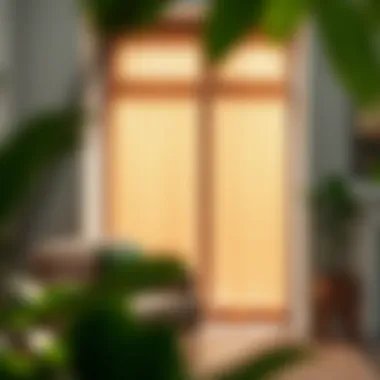

In recent years, the conversation around sustainability has gained momentum across many sectors, and window treatments are no exception. When choosing vertical blinds, especially those sized at 108 x 84 inches, it’s essential to consider the environmental impact of the materials and brands involved. Sustainable practices in blinds selection not only benefit the planet but can also enhance the quality of life in your home. From reducing carbon footprints to supporting ethical manufacturing processes, there are myriad factors to take into account when making a purchase decision.
One of the core elements in promoting sustainability is the choice of materials. When homeowners opt for eco-friendly options, they significantly contribute to waste reduction. This advantage doesn't only lie in the materials used; it extends into the lifecycle of the product, encouraging a move towards longer-lasting, renewably sourced solutions.
Eco-Friendly Materials
When we talk about eco-friendly materials in the context of vertical blinds, several options stand out. Incorporating these materials helps in minimizing environmental impact while still providing the functionality and aesthetic appeal that homeowners desire.
- Bamboo: Known for its rapid regrowth rate, bamboo is a prime candidate for sustainable blinds. Its natural look lends warmth to any space, making it a popular choice.
- Recycled Fabrics: Some companies now offer vertical blinds made from 100% recycled materials, including plastics that would otherwise end up in landfills. This approach not only utilizes existing resources but also promotes a circular economy.
- Natural Fibers: Options such as jute and hemp can be considered sustainable as they are biodegradable and derived from renewable resources. They can provide a unique texture which adds character to any room.
Selecting blinds crafted from these eco-friendly materials can lead to better indoor air quality too, as they are often treated with fewer harmful chemicals compared to conventional options. Although a bit pricier upfront, the long-term benefits of supporting sustainable practices are well worth the investment.
Sustainable Brands and Practices
As the demand for eco-friendly products rises, numerous brands have embraced sustainable manufacturing practices. This sector of the market not only prioritizes environmentally-friendly materials, but also emphasizes ethical labor standards, transparency, and renewable energy sources.
- Lutron: This brand has made a name for itself with its commitment to sustainable production methods. Their energy-efficient blinds can significantly lower electricity bills, reducing reliance on heating and cooling systems.
- Hunter Douglas: Renowned for its innovative designs, this company integrates recycled materials into their production and maintains a strong dedication to responsible sourcing and manufacturing processes.
- Lafayette Interior Fashions: They emphasize sustainability by utilizing low-impact manufacturing processes and providing options made from natural fibers.
Choosing brands that prioritize sustainable practices not only aligns with eco-conscious values but can also lead to high-quality, durable products. Before purchasing, researching a brand's sustainability credentials can provide peace of mind and ensure that you are making an environmentally responsible choice.
"Sustainable blinds are a small step in the right direction, but collectively, they can lead to monumental change for our environment."
Comparative Analysis of Vertical Blinds Brands
When embarking on the journey of selecting vertical blinds, especially those falling within the 108 x 84 specifications, it becomes pivotal to conduct a thorough comparative analysis of brands. Not all vertical blinds are created equal, and discerning the nuances can make a world of difference in terms of durability, style, and functionality. Evaluating different brands not only facilitates informed purchases but also ensures that customers can derive maximum value from their investment.
The importance of this comparative analysis lies in several specific elements:
- Performance: Each brand boasts its own design philosophy and manufacturing process, which directly impacts performance. This can include how well the blinds help to control light, resist wear and tear, and even insulate against heat or cold.
- Materials and Aesthetics: With a plethora of materials available—be it vinyl, fabric, or aluminum—the variety can be overwhelming. Understanding which brands utilize high-quality materials enables buyers to align their choice with their aesthetic preferences and functional needs.
- Pricing and Value: A thorough examination helps identify which brands balance quality with cost-effectiveness. Some might come with premium pricing but not offer any additional benefits, while others provide excellent quality at a more reasonable price point.
- Warranty and Customer Service: Reliable brands typically back their products with competitive warranties and responsive customer service. This consideration can save a lot of headaches in the long run.
The comparative analysis not only assists buyers in making sound choices but also fosters an environment of competitiveness among manufacturers, encouraging innovation and better service.
Leading Brands Overview
In the world of vertical blinds, a few brands stand out from the crowd due to their reputation, quality, and customer satisfaction. These brands are often synonymous with durability and design excellence. Here are a few to consider:
- Hunter Douglas: Known for their innovative designs and quality materials, Hunter Douglas offers a vast selection of vertical blinds that combine functionality with style. Their products often come equipped with energy-efficient features, appealing to eco-conscious buyers.
- Blinds.com: This brand is recognized for its extensive range of customizable options, allowing consumers to tailor their vertical blinds according to their specific needs and preferences. They often boast user-friendly installation procedures.
- ** Bali Blinds**: Bali is celebrated for its balanced approach to both affordability and quality, making it a popular choice among homeowners and renters alike. Their vertical blinds are crafted with attention to detail and come in a rich array of colors and textures.
- Levolor: With a history dating back to 1914, Levolor emphasizes craftsmanship and customer care. Their vertical blinds are often praised for their ease of operation and classic designs.
These leading brands exemplify varying approaches to manufacturing vertical blinds, ensuring that buyers have a broad spectrum to choose from, based on individual needs.
Performance Assessments
When it comes to assessing the performance of vertical blinds, several metrics should be examined. Buyers are often interested in how well these blinds perform in real-life conditions, beyond mere aesthetics.
- Light Control: One of the primary functions of vertical blinds is to regulate the entry of light. Brands like Hunter Douglas often integrate advanced mechanisms that allow for precise manipulation of slats, enabling users to achieve desired levels of brightness or darkness.
- Durability: The resilience of materials used is essential. Brands such as Levolor and Bali Blinds are known for their robust offerings, employing materials that can withstand daily use without fading or becoming brittle over time.
- Ease of Maintenance: The practicality of vertical blinds also plays a crucial role in their performance. Some brands provide finishes that are easier to clean and care for, which can’t be overlooked in high-traffic areas.
- Insulation Properties: Energy efficiency is increasingly becoming a benchmark for performance assessment. Brands like Hunter Douglas tout their insulated models, which contribute to overall energy savings.
By taking into account these performance assessments, buyers can ascertain which vertical blinds genuinely meet their needs while ensuring that their investment is sound.
The End and Recommendations
In navigating the journey to select vertical blinds, particularly those with dimensions of 108 x 84 inches, several pivotal elements emerge from our comprehensive exploration. Vertical blinds not only enhance aesthetic appeal but also play a crucial role in functionality, practicality, and energy efficiency. Given the array of materials available—from fabric to aluminum—homeowners are presented with a cornucopia of choices that align with both style and durability.
One of the primary considerations when selecting these window coverings should be the balance between light control and privacy. Vertical blinds allow homeowners to finely tune the amount of sunlight pouring into a room while ensuring that one's privacy remains intact. Optimal control of daylight contributes to a comfortable environment, making the correct choice of vertical blinds an investment toward a better living space.
Energy efficiency is another significant factor. Blinds that fit snugly and are made from insulating materials can help maintain consistent indoor temperatures, which in turn reduces heating and cooling costs. Thus, selecting the right blinds is not just about aesthetics but also about creating an efficient home environment.
In short, making an informed decision regarding vertical blinds requires careful consideration of the following:
- Material choice: Determine if fabric, vinyl, or aluminum aligns better with your lifestyle and decor.
- Light control needs: Assess how much light you want to block out during the day versus how much privacy you prefer.
- Energy efficiency impact: Consider how your choice can affect heating and cooling needs.
- Aesthetic harmony: Ensure the blinds complement your overall decor and style.
With the right mix of these considerations, buyers can ensure the vertical blinds they select will serve their intended purpose efficiently while enhancing the beauty of their spaces.
Key Takeaways
Vertical blinds sized 108 x 84 inches present a versatile solution for window treatment, blending functionality with a broad spectrum of design options. A few key takeaways include:
- Versatile designs: Available in various colors and materials to match different interior styles.
- Energy saver: Can reduce energy bills by providing better heat management.
- Functional performance: Excellent in light modulation and privacy management.
- Maintenance: Relatively easy to clean and maintain, prolonging their lifespan.
Final Considerations for Buyers
Before finalizing a purchase, it's essential for buyers to evaluate their specific needs thoroughly. Here are a few critical considerations:
- Measure accurately: Always double-check measurements to ensure the perfect fit.
- Consider your environment: Think about the varying weather conditions in your area, which may influence material choice.
- DIY vs. Professional installation: Determine if you feel comfortable handling installation yourself or if professional help is warranted.
- Warranty and support: Look for brands that offer good customer service and product warranties.
For additional resources on vertical blinds or to gain more insights into features and specifications, consider visiting Wikipedia or Britannica.















